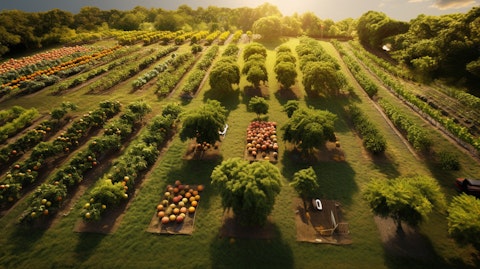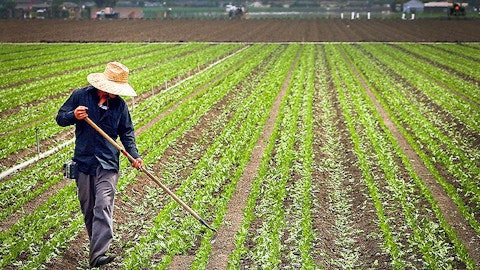Bunge Limited (NYSE:BG) Q4 2023 Earnings Call Transcript February 7, 2024
Bunge Limited isn’t one of the 30 most popular stocks among hedge funds at the end of the third quarter (see the details here).
Operator: Good morning and welcome to the Bunge Global SA Fourth Quarter 2023 Earnings Release and Conference Call. [Operator Instructions] Please note that this event is being recorded. I would like now to turn the conference over to Ruth Ann Wisener. Please go ahead.
Ruth Ann Wisener: Thank you Maria, and thank you for joining us this morning for our fourth quarter earnings call. Before we get started, I want to let you know that we have slides to accompany our discussion. These can be found in the Investor Center on our website at bunge.com, under Events and Presentations. Reconciliations of non-GAAP measures to the most directly comparable GAAP financial measures are posted on our website as well. I’d like to direct you to Slide 2 and remind you that today’s presentation includes forward-looking statements that reflect Bunge’s current view with respect to future events, financial performance, and industry conditions. These forward-looking statements are subject to various risks and uncertainties.
Bunge has provided additional information in its reports on file with the SEC concerning factors that could cause actual results to differ materially from those contained in this presentation, and we encourage you to review these factors. On the call this morning are Greg Heckman, Bunge’s Chief Executive Officer; and John Neppl, Chief Financial Officer. I’ll now turn the call over to Greg.
Gregory Heckman: Thank you Ruth Ann, and good morning everyone. 2023 was a significant year for Bunge with both our continued strong financial performance and progress on our long term strategy. I want to thank the team for their exceptional execution on our day to day business while also focusing on key projects for the future. First and foremost, we announced our pending combination with Viterra to create a premier agribusiness solutions company. We received overwhelming shareholder approval and our team’s been hard at work planning for a successful integration when we close the transaction, which we expect to occur later this year. We continue engaging with relevant authorities in countries around the world as we make progress on regulatory approvals.
In addition to the Viterra transaction, we announced the planned acquisition of CJ Selecta, a leading fully integrated manufacturer and exporter of soy-based products in Brazil. We broke ground on our soy protein concentrate plant in Morristown, Indiana with construction on track for a 2025 commissioning. We also completed the acquisition of a state of the art oil refinery in Avondale, Louisiana. This facility, which has multi oil capabilities, builds on our ability to provide value added oils to our food customers in North America and is already exceeding our initial performance expectations and in the next few months, we’ll be commissioning our new multi-oil refining and packaging plant in India. These growth initiatives will enable us to meet rising demand for plant based food and feed ingredients.
Investments to enhance our existing footprint are also paying off in improved overall performance. Our team continued to execute on planned capital projects which, when combined with our focus on operational excellence, enabled us to reduce oil seed processing unplanned downtime to a historic low making better use of our capacity directly hits the bottom line. These investments were also made with an eye towards advancing our work in sustainability. Running our plants more efficiently improves our performance against our science-based targets and we’re committed to continuous improvement of our operations while expanding regenerative agricultural programs and engaging with the industry to do our part to reduce carbon emissions across the entire supply chain.
We’re proud of our team’s many accomplishments in 2023, a year in which Bunge was selected to be part of the S&P 500, a landmark moment for our company and reflective of the work we’ve accomplished to transform our business over the last several years. Looking at the fourth quarter specifically, we delivered strong adjusted EBIT, driven by record results in processing and improved results in milling. During the quarter we continued to return capital to shareholders through stock repurchases and dividends. Looking ahead as we’ve been reminded over the past few years, the only constant is change. Each year brings its own set of challenges and opportunities, and the team has shown we can navigate with agility and speed. Based on the current margin, environment, and forward curves the market dynamic in 2024 looks to be different than what we experienced in 2023, and as often the case, forward visibility is limited at this point in the year.
For the full year, we expect to generate adjusted EPS of approximately $9. John will go through our forecast in more detail. I want to reiterate that the work we’ve done to transform Bunge has created a company better equipped to operate in any market environment and with the combination of Bunge and Viterra we will continue to improve our global platform, making it more efficient and resilient, allowing us to better serve our customers at both ends of the value chain. I’ll hand the call over to John now to walk through our financial results and outlook in more detail and I’ll then close with some additional thoughts. John?
John Neppl: Thanks Greg, and good morning everyone. Let’s turn to the earnings highlights in Slide 5. Our reported fourth quarter earnings per share was $4.18 compared to $2.21 in the fourth quarter of 2022. Our reported results included a positive mark to market timing difference of a $1.8 per share and a negative impact of $0.60 per share primarily related to acquisition and integration costs associated with our announced business combination with Viterra, as well as a fixed asset impairment charge. Adjusted EPS was $3.70 in the fourth quarter versus $3.24 in the prior year. Full year 2023 earnings per share was $14.87 versus $10.51 in 2022. Adjusted full year EPS was $13.66 versus a record $13.91 in the prior year. Adjusted core segment earnings before interest and taxes, or EBIT, was $881 million in the quarter versus $804 million last year.

Agribusiness had a strong close to the year processing results in the quarter, up $132 million primarily related to South America, Europe, and Canada more than offsetting lower results in the U.S., which had a difficult comparison to a particularly strong prior year. Results in Asia were comparable to last year. In merchandising results in the quarter were down in all businesses, reflecting lower volatility. Refined and specialty oils finished a record year with strong fourth quarter results of $212 million. Performance for the quarter was down slightly from last year as higher results in North and South America were more than offset by lower results in Europe and Asia. In milling, improved results in the quarter were primarily driven by our South American operations, reflecting higher margins due to the combination of lower wheat costs and a more favorable pricing environment.
Results in U.S. corn milling also improved. Corporate and other improved from last year. Higher corporate expenses related to investments and growth initiatives were more than offset by positive results in our captive insurance program and Bunge Ventures. In our non-core Sugar and Bioenergy joint venture, results were lower as higher sugar prices were more than offset by lower ethanol prices. For the quarter reported income tax expense was $219 million compared to $131 million for the prior year. The increase was primarily due to higher pretax income and geographic earnings mix. Adjusting for notable items and mark-to-market timing differences, the full year adjusted effective income tax rate was 23% compared to 17% for the prior year. Net interest expense of $115 million in a quarter was up compared to last year, primarily due to higher interest rates.
Also impacting the quarter were foreign currency borrowings in certain countries where interest rates were high. However, the incrementally higher borrowing costs were offset with currency hedges reported within EBIT. Let’s turn to Slide 6, where you can see our EPS and EBIT trends adjusted for notable items and timing differences over the past five years. The strong performance reflects our team’s continued excellent execution in a favorable operating environment while also delivering on a variety of initiatives to position the company for long term growth. Slide 7 details our capital allocation. In 2023, we generated approximately $2.5 billion of adjusted funds from operations, which was up by approximately $110 million versus 22s record performance.
After allocating $488 million to sustaining CapEx, which include maintenance, environmental health and safety, we had approximately $2 billion of discretionary cash flow available. Of this amount, we paid $383 million in common dividends, invested $634 million in growth and productivity related CapEx, which is up significantly from $249 million last year, and repurchased $600 million of Bunge shares, leaving $361 million retained cash flow for the year. Moving to Slide 8, we finished 2023 with a total CapEx spend of approximately $1.1 billion and expect to invest $1.2 to $1.4 billion in 2024. Our sustaining CapEx has been higher, reflecting post pandemic catch up and increased investments in operational and reliability, where we are already seeing the benefits through reduced unplanned downtime.
Also, our discretionary spend is up due to executing on our pipeline of growth projects, many of which are multiyear investments. We expect continued elevated spend in 2025 as we complete these projects. As shown on Slide 9, at year end, readily marketable inventory, or RMI, exceeded our net debt by approximately $3.5 billion. This reflects our use of retained cash flow to fund working capital while reducing debt. Our adjusted leverage ratio, which reflects our adjusted net debt to adjusted EBITDA, was 0.2x at the end of the fourth quarter. Slide 10 highlights our liquidity position. At year end, all $5.7 billion of our committed credit facilities was unused and available. This provides us ample liquidity to manage our ongoing capital needs.
Please turn to Slide 11. For the trailing 12 months, adjusted ROIC was 18.4%, well above our RMI adjusted weighted average cost of capital of 7.7%. ROIC was 14.3%, also well above our weighted average cost of capital of 7%. Moving to Slide 12. For the trailing 12 months, we produced discretionary cash flow of approximately $2 billion and a cash flow yield of 18.2%. Please turn to Slide 13 and our 2024 outlook. As Greg mentioned in his remarks, taking into account the current margin, environment and forward curves, we expect full year 2024 adjusted EPS of approximately $9. Note that this forecast excludes any pending acquisitions that are expected to close during the year. In agribusiness, full year results are forecasted to be down from last year’s record performance, primarily due to lower results in processing where margins have compressed in most regions.
Results in merchandising are forecasted to be down slightly from last year. In refine and specialty oils full year results are expected to be down from the record prior year, reflecting an environment of increased supply, particularly in the U.S. In milling, full year results are expected to be up from last year and in corporate and other full year results are also expected to be up from last year. In non-core, full year results in our Sugar and Bioenergy joint venture are expected to be down considerably from last year, reflecting lower Brazilian ethanol prices. Additionally, the company expects the following for 2024. An adjusted annual effective tax rate in the range of 21% to 25% net interest expense in the range of $300 to $330 million capital expenditures in the range of $1.2 to $1.4 billion and depreciation and amortization of approximately $450 million.
With that, I’ll throw things back over to Greg for some closing comments.
Gregory Heckman: Thanks John. Before turning to Q&A, I want to offer a few closing thoughts. So we’re proud of the work we’ve done to optimize our business and we’re always looking for ways to drive continuous improvement. We’ve got a clear set of priorities, continue that work in 2024, and we’re confident that we’ll end the year as an even stronger Bunge. We’re making great progress towards closing our combination with Viterra, which will increase diversification across assets, geographies, and crops, providing us with more optionality and capabilities to serve customers, and we continue to invest in our people and global infrastructure through effective training and proper tools, we can safely and reliably meet our customers needs.
We’re also working on a number of initiatives to best equip our team for the future, including strengthening our digital capabilities. We’re making these investments to meet the longer term demand growth for our products and services. And while always looking for opportunities to improve, we are well positioned to deliver on our critical mission of connecting farmers to consumers, to deliver essential food, feed, and fuel to the world. And with that, we’ll turn to Q&A.
See also 30 Highest Paying Part Time Jobs for 16 Year Olds and 12 Best Foreign Dividend Stocks To Invest In.
Q&A Session
Follow Bungeltd (NYSE:BG)
Follow Bungeltd (NYSE:BG)
Operator: [Operator Instructions] The first question is from Ben Bienvenu of Stephens. Please go ahead.
Ben Bienvenu: Hi. Good morning, everybody.
Gregory Heckman: Good morning, Ben.
Ben Bienvenu: So over the last several years, there’s clearly been building tailwinds for the business. You’ve capitalized on it very nicely as we get to this point in the cycle some of those tailwinds certainly moderate, as expressed in your guidance. And you noted, Greg, that as usual, but particularly now, there’s maybe a little bit less visibility into the business looking forward, if you can think through your business segments, can you help us understand where you feel like you have the most visibility versus the least and some of the key things that you’re focused on to maybe gain greater visibility for the year as we move through the year?
Gregory Heckman: Yes, sure. Thanks, Ben. I think, as usual, the first quarter is where we have the most visibility, and then it starts to kind of reduce as we go out. Having the global platform, of course, is very helpful. And so as we look across crush today, as we said, and we look at the curves and what they give us, they’re all inverted with some pretty limited liquidity beyond Q1 and then we’re in that what we do have visibility to, and you kind of think about history, we’re in that transition as markets get a little more balanced on supply and demand, that producers generally don’t like selling lower prices and they’ve got room to storage. So you see a little bit generally reluctant selling as we transition from the farmer and then the end consumer we see them having an incentive to wait.
So they’re becoming also more short purchased and buying in the spot as prices are balancing and the supply chain is not quite as tight. So those are some of the key things that we’re watching that, of course, affect both crush and merch and our refined and specialty oil and milling altogether.
Ben Bienvenu: Okay, very good. My second question is related to a similar dynamic. As we kind of have shifting winds in the cycle, operationally, organizationally, tactically, you all have positioned the business to maximize earnings power as the cycle was accelerating to the upside over the last number of years. Externally, you’ve done a masterful job of managing expectations, and I think your track record of guiding conservatively is well established at this point. As we get to a slightly different backdrop, how does your focus internally change, if at all? How do the changes that you’ve made historically positioned you to also maximize earnings power as we see more balanced supply demand? And then how, if at all, does your external expectation management change in this sort of environment, if at all, versus what we’ve seen in the last several years?
Gregory Heckman: Well, I just would start by saying the same things that we’ve been focused on really work in all environments. And I think we talked as we were going we were always thinking about trying to build the company for the bottom of the cycle, which you hope you never experience. But if we have that mindset and we have our costs in position to be the most efficient, regardless of where you are in the cycle, that we have our business organized in our operating model to have the most nimble and agile and ability to react to whatever the external factors that we can’t control in the market, and that we ensure that we have got our rewards systems in alignment with our stakeholders and with our investors and with our customers at both ends of the value chain, that we’re going to operate the same on the things that we can control, and I think we talked about it in the past, you got to continue to think about, this is a big food and fuel global infrastructure, right, to serve our customer.
And we still have the billions of dollars of assets, we still got the tens of thousands of customers, we still got the millions of tons of physical flows and that is the embedded optionality that exists and so while we don’t control the markets, we do control how we manage day to day. So we stay focused on what we can control and then unlock that value as we’re helping balance supply and demand across our businesses for our customers at both ends of the value chain. That’s just – that’s kind of maniacal focus every day.
Ben Bienvenu: Okay, great. Thanks so much. Thanks for taking my questions.
Gregory Heckman: Thanks, Ben.
Operator: The next question is from Manav Gupta with UBS.
Manav Gupta: Good morning, guys. Congrats on a very strong quarter. You came in well ahead of expectations, so congrats on that. My question here is, it’s more of a help if you could provide. You have a $9 guidance for 2024, which we think is conservative, but help us understand if Viterra does close on, let’s say, July 1, then where could this $9 go based on the current environment, whatever help you could provide would be highly appreciated.
John Neppl: Sure. Manav, this is John. I think what we’ve communicated in the past, I think our view is on Viterra close in 2024 will be mildly accretive to flat in the first year. We’ve got a lot of synergy costs, a lot of integration costs to incur and certainly for the first six to 12 months, there’ll be a lot of work around integration and focused on that. I think we love the business and I think the long term is outstanding, especially when you look at environment like we’re going into. But I wouldn’t expect a significant impact on the $9 in this year.





